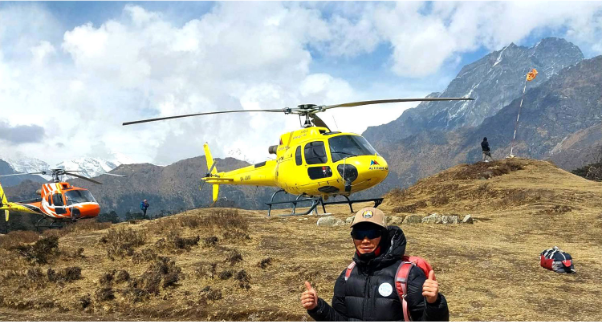The Everest Base Camp Trek has long been one of the most coveted trekking routes in the world. For adventurers, it’s a pilgrimage to the heart of the Himalayas, offering awe-inspiring views of towering peaks, a deep sense of connection to nature, and the thrill of reaching an iconic destination. However, the trek can be grueling and time-consuming. This is where the innovative Everest Base Camp Trek with Helicopter Return offers a luxurious, time-efficient, and exhilarating way to experience the grandeur of the Everest region.
In this article, we will explore the Everest Base Camp Helicopter Trek, focusing on the journey itself, the benefits of combining trekking with a helicopter return, practical information, and everything you need to know about this increasingly popular adventure.
What is the Everest Base Camp Helicopter Trek?
The Everest Base Camp Helicopter Trek with Helicopter Return is a fusion of a classic trekking experience combined with the convenience of a helicopter ride back from Everest Base Camp. Traditionally, trekkers would need to hike for several days to reach the Everest Base Camp at 5,364 meters (17,598 feet), and the return journey would take an additional 3-4 days. While many adventurers enjoy the entire trek, the idea of skipping the return leg by helicopter has gained popularity due to time constraints, physical challenges, or the desire for a unique experience.
The trek begins with a scenic flight from Kathmandu to Lukla, the starting point for the Everest Base Camp trek. From there, trekkers proceed with the standard trek, passing through Sherpa villages, Buddhist monasteries, and stunning mountain landscapes. The final stretch leads to Everest Base Camp, where trekkers can marvel at the view of Mount Everest and its surrounding peaks.
Instead of retracing their steps on foot, trekkers can then board a helicopter for the return journey, flying over the same rugged terrain but from a bird’s-eye view, capturing breathtaking aerial views of the Himalayas, glaciers, and valleys below. The helicopter lands back in Lukla, where trekkers can fly back to Kathmandu and conclude their adventure.
Key Benefits of the Everest Base Camp Helicopter Trek
- Time-Efficiency The main appeal of the Everest Base Camp Helicopter Trek is the ability to complete the journey in less time. Typically, the round-trip trek can take around 12-14 days, but by taking a helicopter back from Everest Base Camp, the journey can be condensed to a 7-9 day adventure. This is ideal for travelers with limited time who still want to experience the Everest region.
- Comfort and Luxury Trekking to Everest Base Camp is an arduous experience that demands a lot of physical exertion. By opting for a helicopter return, trekkers can avoid the physically demanding return trek, reducing exhaustion and allowing them to enjoy the last leg of the trip in comfort and luxury. The helicopter flight offers unparalleled views and a sense of relaxation after several days of trekking.
- Stunning Aerial Views The helicopter return allows trekkers to enjoy one of the most incredible aerial views of the Everest region. Flying over the Khumbu Glacier, Mount Everest, and the surrounding peaks offers a perspective that is not available to those trekking on foot. The majestic scale and beauty of the Himalayas are best appreciated from the air, creating unforgettable memories.
- Avoiding Altitude Fatigue While trekking up to Everest Base Camp is an exciting challenge, the trek’s altitude can cause fatigue and discomfort, especially when trekkers have to descend after reaching the summit. Taking a helicopter back eliminates the need for descending at high altitudes, reducing the risk of altitude sickness and helping trekkers avoid potential health issues.
- Perfect for Non-Trekkers Not everyone is physically prepared for the strenuous trek to Everest Base Camp. However, with the helicopter return, those who are less able to handle the full trek can still enjoy the views and sense of accomplishment without exerting themselves over long days of hiking.
The Everest Base Camp Helicopter Trek Experience
- The Journey to Lukla The adventure begins with a flight from Kathmandu to Lukla, a small town perched in the mountains of Nepal. The flight to Lukla is an experience in itself, offering a glimpse of the Himalayan range from a distance. Upon landing, trekkers begin the classic trek to Everest Base Camp, passing through the picturesque villages of Phakding, Namche Bazaar, Tengboche, Dingboche, and Gorak Shep, before reaching Base Camp.
- The Trek to Everest Base Camp The trek to Everest Base Camp typically takes 7-10 days. Along the way, trekkers encounter lush forests, alpine meadows, glaciers, and Sherpa settlements. One of the highlights of the trek is the visit to the Tengboche Monastery, where trekkers can observe Buddhist prayer ceremonies and immerse themselves in Sherpa culture. The trekking route offers spectacular views of Everest, Lhotse, Nuptse, Ama Dablam, and other towering peaks.
- Arriving at Everest Base Camp Reaching Everest Base Camp is a significant achievement for trekkers. The view of the Khumbu Icefall, the immense glaciers, and the towering Mount Everest is overwhelming. Many trekkers spend a few hours at Base Camp, taking photos and relishing the accomplishment before preparing for the helicopter return.
- Helicopter Return The helicopter return is one of the most thrilling parts of the journey. From Everest Base Camp, the helicopter takes off, flying over the vast Khumbu Glacier, past towering peaks, and across valleys. The aerial view offers unique perspectives of the Everest region, which are inaccessible by foot. The helicopter journey lasts about 20-30 minutes before landing back in Lukla, from where trekkers fly back to Kathmandu.
Important Considerations
- Weather Conditions Helicopter flights are highly dependent on the weather. Weather conditions in the Everest region can change rapidly, and helicopter flights may be delayed or canceled if there are unfavorable conditions. It’s important to allow for flexibility in your travel schedule and have extra days in case of delays.
- Altitude and Acclimatization Although the helicopter return provides a swift escape from the high altitudes of Everest Base Camp, trekkers should still acclimatize properly on the way to Base Camp. Proper acclimatization is crucial to avoid altitude sickness and ensure a safe and enjoyable trek.
- Physical Fitness Even though the helicopter return reduces the physical exertion of the trek, the hike to Everest Base Camp itself is still challenging. Trekkers should be in good physical condition and prepared for several days of moderate to strenuous trekking.
- Cost The Everest Base Camp Helicopter Trek is a more expensive option compared to the traditional trek, due to the inclusion of the helicopter ride. It is recommended to check with tour operators to get a clear breakdown of costs and ensure the package suits your budget.
Conclusion: Key Takeaways
The Everest Base Camp Helicopter Trek is an exceptional way to experience the beauty and grandeur of the Everest region without the demanding return trek. Combining the thrill of reaching Everest Base Camp on foot with the luxury of a helicopter return offers a perfect balance of adventure and comfort. Whether you’re short on time, looking to reduce physical strain, or simply want to enjoy a unique perspective of the Himalayas, this trek provides an unforgettable experience.
For those with a spirit of adventure but limited time or physical capacity, this trek offers the ideal solution. It allows trekkers to savor the majesty of Everest while eliminating the need for a taxing return trek. With breathtaking aerial views, the convenience of a shorter itinerary, and the luxury of a helicopter return, the Everest Base Camp Helicopter Trek promises an adventure that will stay with you for a lifetime.
FAQ:
Q1: How long does the Everest Base Camp Helicopter Trek take?
The trek typically lasts 7-9 days, including the time spent hiking to Everest Base Camp and taking the helicopter return.
Q2: Is it necessary to have previous trekking experience?
Although prior trekking experience is beneficial, it is not a strict requirement. The trek to Everest Base Camp is demanding, but it is accessible for reasonably fit individuals who are in good health.
Q3: What are the costs involved in the Everest Base Camp Helicopter Trek?
The cost varies depending on the tour operator, package inclusions, and group size. On average, the cost ranges from $2,500 to $4,000 USD per person. This includes permits, trekking guides, accommodations, and the helicopter ride.
Q4: What if the helicopter flight is canceled due to bad weather?
Weather conditions in the Everest region are unpredictable, and flights can be delayed or canceled. It is advisable to allow extra time in your itinerary in case of weather-related delays.
Q5: Is it safe to take a helicopter from Everest Base Camp?
Yes, it is safe to take a helicopter back from Everest Base Camp. Helicopter operators in Nepal are experienced, and safety protocols are strictly followed. However, flights are subject to weather conditions.

